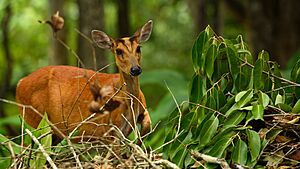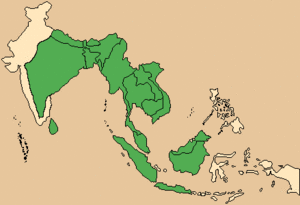Northern red muntjac facts for kids
Quick facts for kids Northern red muntjac |
|
|---|---|
 |
|
| Northern red muntjac (♀) pictured in Khao Yai National Park, Thailand, July 2015 | |
| Conservation status | |
| Scientific classification | |
| Genus: |
Muntiacus
|
| Species: |
vaginalis
|
 |
|
| Range of the northern red muntjac (M. vaginalis) and the southern red muntjac (M. muntjak) | |
The Northern red muntjac (Muntiacus vaginalis) is a type of small deer. It is also known as the barking deer because of the loud sound it makes when it feels danger. This animal lives in many countries across south-central and southeast Asia.
Contents
About the Northern Red Muntjac
The Northern red muntjac is a shy animal. It usually lives alone or in pairs. These deer are active during the day and night. They eat leaves, fruits, and seeds. Male muntjacs have small antlers. They use these antlers to fight other males.
How Scientists Classify This Deer
For a long time, scientists thought the Northern red muntjac was the same as the Southern red muntjac. They look very similar! But recently, after studying them closely, scientists found they are actually different species.
This means that some muntjac populations once thought to be Southern red muntjacs are now known to be Northern red muntjacs. It's like finding out two very similar-looking cousins are actually from different families.
Where These Deer Live
The Northern red muntjac lives in many places. You can find them in twelve countries in Asia. These include Pakistan, Bhutan, Myanmar, Nepal, India, Sri Lanka, and Bangladesh. They also live in China, Cambodia, Laos, Thailand, and Vietnam.
You can also find them in Hong Kong. Scientists are still checking if they live in Malaysia. These deer prefer forests and areas with lots of plants.
Protecting the Northern Red Muntjac
The IUCN (International Union for Conservation of Nature) lists the Northern red muntjac as "Least Concern". This means they are not in immediate danger of disappearing. There are a few reasons for this. They live in a very large area. Many of them live in protected parks and reserves. They are also quite good at surviving, even with some hunting and changes to their homes.
However, their numbers are going down in some areas. This is because their homes (habitats) are being destroyed. People also hunt them for their meat and body parts. Protecting their forests is important to keep these unique deer safe for the future.


